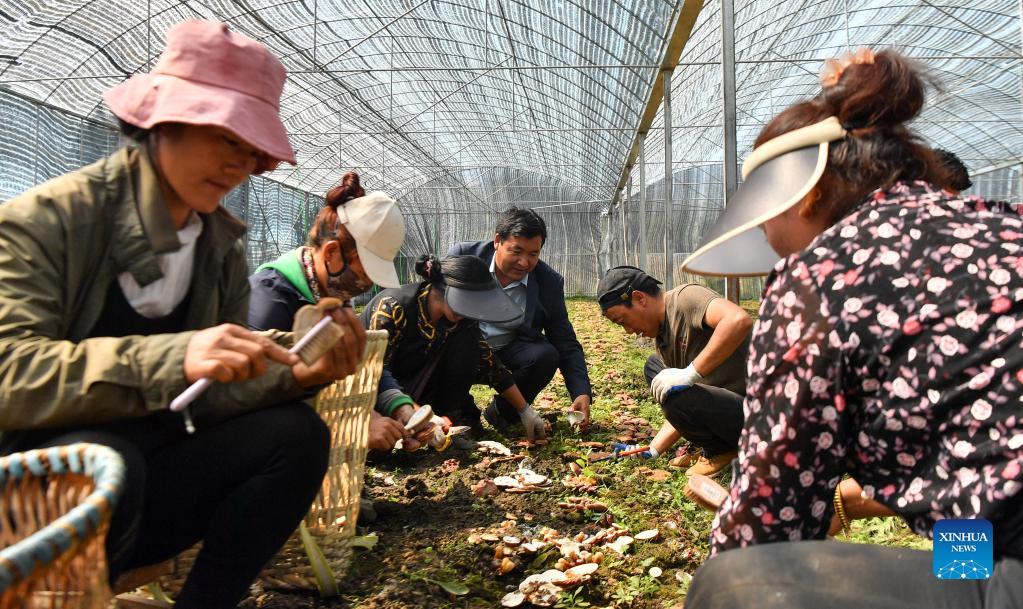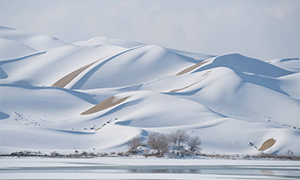Xi and Tibet -- footprints and blueprint for a green future

Padma Tsering, a forest ranger, plays with a dog at a ranger station in Nyingchi, southwest China's Tibet Autonomous Region, Oct. 14, 2021. (Xinhua/Jigme Dorje)
LHASA, Dec. 8 (Xinhua) -- Decades ago, millennia-old verdant forests were nothing but a source of income for Jigme, a former logger in southwest China's Tibet Autonomous Region.
However, a trip to a local cypress park completely changed his understanding of environmental protection.
"What shocked me most were the cries of amazement from tourists on seeing the giant cypress trees there," Jigme said. "That's when it occurred to me that what I had been doing for so long might be wrong."
Across Tibet, "lucid waters and lush mountains are invaluable assets" -- the concept raised by Chinese President Xi Jinping is thriving in people's hearts. Today, Tibet is home to one of the most pristine natural environments on earth.
FRESH FOOTPRINTS ON PLATEAU
Xi, also general secretary of the Communist Party of China (CPC) Central Committee and chairman of the Central Military Commission (CMC), has set foot in the plateau region three times since the late 1990s, at an average altitude of around 4,000 meters.
His latest visit was made this July, less than a month before Tibet held a series of activities celebrating the 70th anniversary of its peaceful liberation, a historic event that led the region onto a road of unity, progress and development.
The first leg of Xi's inspection tour was Jigme's hometown Nyingchi, where he visited the Nyang River Bridge to learn about the ecological preservation of the Yarlung Zangbo River and its tributary Nyang, as well as the construction of nature reserves. There, Xi underscored the importance of protecting and restoring the ecology of the major river basins.
He also visited the city planning hall of Nyingchi, where he called for scientifically delineating the boundaries of urban development and drawing red lines for protecting ecosystems. His itinerary also included a village with a booming peach-blossom tourism sector, a city park in Nyingchi, and several places in the regional capital Lhasa.
It was the first time in the history of the Party and the country that a leader visited Tibet on the anniversary of its peaceful liberation in the capacities of general secretary of the CPC Central Committee, Chinese president and chairman of the CMC.
"It is a clear expression of the CPC Central Committee's support for Tibet work and solicitude for cadres and people of all ethnic groups in the region," Xi stressed.
Jigme said he was excited when learning of Xi's visit to his hometown, adding "I can feel that Tibet is very close to the general secretary's heart."
In 1998, Xi, then a deputy secretary of the CPC Fujian Provincial Committee, visited Tibet with the task of overseeing the province's pairing-up assistance to the plateau region.
Ten years ago, Xi headed a central delegation to Tibet to celebrate the 60th anniversary of its peaceful liberation. The then Chinese vice president called Tibet "an important ecological security barrier, a major base of strategic resources reserve and a major production area of special highland farm produce."
BLUEPRINT FOR GREEN DEVELOPMENT
Since 1978, the CPC Central Committee has held seven symposiums on Tibet, making major decisions and plans for the region.
Entering the new era following the 18th CPC National Congress in 2012, the CPC Central Committee with Xi Jinping at the core has attached great importance to the development of Tibet, and Xi has set the direction and made overall plans for the region, drawing up the blueprint for future development.
He presided over the sixth and seventh central symposiums on Tibet work, defining guiding principles, objectives and tasks in the new era. It was decided at the meetings that the central government would support a number of key construction projects in Tibet, and a series of special preferential policies were enacted.
At the seventh central symposium on Tibet work held last year, Xi expounded on "the guidelines for governing Tibet in the new era," with "prioritizing ecological protection" as an important part of the "10 musts" for advancing the region's development.
"Conserving the ecology of the Qinghai-Tibet Plateau is the greatest contribution to the survival and development of the Chinese nation," Xi said.
This focus on green development was reiterated during his July visit.
Xi emphasized the four major issues of stability, development, ecology and border-area consolidation, and called for new achievements in protecting the ecology on the plateau and advancing its sustainable development.
While visiting the Nyang River Bridge, Xi urged the local authorities to effectively protect the region's "vegetation, living creatures, waters and mountains."
"Next, it is our bounden duty to protect the plateau region," said Dradul, head of Nyingchi's forestry and grassland bureau, who briefed Xi on the local government's eco-protection work along the Yarlung Zangbo and Nyang rivers.
"We will endeavor to effectively protect the lush vegetation here, and ensure people will be surrounded by green wherever they venture," Dradul added.
IMPRINTS ON PEOPLE'S MINDS
Now, the catchphrase that "lucid waters and lush mountains are invaluable assets" is not only shown on public posters, but also firmly imprinted on the minds of all people in Tibet.
Paljor, a 62-year-old tree planter in the city of Shannan, has been both a contributor and a beneficiary of the region's greening endeavor.
Over the past years, he has turned some 27 hectares of barren land in Shannan into a nursery by planting over 70 types of trees.
With the support of the local government, his gardening center now has an annual output of about 4 million yuan (around 628,000 U.S. dollars). With his expertise, he has also assisted other areas in Tibet with their greening projects.
"Tibet is now standing at a new historical starting point for advancing ecological progress," said Zhao Kun, deputy head of the regional department of ecology and environment.
"People of all ethnic groups in Tibet will surely play the 'ecology card' well and stick to the green path," Zhao said. "While building Tibet into a highland of ecological civilization, we will share our experience of green development with the rest of the country."
Padma Tsering, a 72-year-old villager in Nyingchi, has put the notion into practice over the past decade. He was chosen to be a ranger 10 years ago, as he knew the nearby forests like the back of his hand from his previous experience as a logger.
"I believe what I'm doing will benefit many future generations," he said.
Jigme also bid farewell to the timber business a long time ago. "Instead of felling trees, we now protect them. With a better environment, we can make a good living by planting edible fungi and cherries, and providing homestay services to tourists," said Jigme, who now earns a stable income from the booming tourism industry.
"Now I'm firmly convinced that clear waters and lush mountains are valuable assets, and so are the snowy and icy landscapes, just like General Secretary Xi put it," Jigme said. "I will tell my children to learn my lesson and better protect nature."

Paljor, a tree planter, views saplings at a seedling base in Shannan, southwest China's Tibet Autonomous Region, July 20, 2021. (Xinhua/Jigme Dorje)

Padma Tsering, a forest ranger, inspects the forest in Nyingchi, southwest China's Tibet Autonomous Region, Oct. 14, 2021. (Xinhua/Jigme Dorje)

Jigme poses for a photo at his homestay in Nyingchi, southwest China's Tibet Autonomous Region, Oct. 13, 2021. (Xinhua/Jigme Dorje)

Jigme (3rd R) talks with workers at a greenhouse cultivating edible fungi in Nyingchi, southwest China's Tibet Autonomous Region, Oct. 13, 2021. (Xinhua/Jigme Dorje)
Photos
Related Stories
- Xi says China to push for new progress in relationship with Iceland
- Xi sends congratulatory letter to 2021 South-South Human Rights Forum
- Xi says China to enhance relations with Germany
- Xi sends congratulatory letter to 2021 South-South Human Rights Forum
- Book of Xi's discourses on safeguarding human rights published
Copyright © 2021 People's Daily Online. All Rights Reserved.










